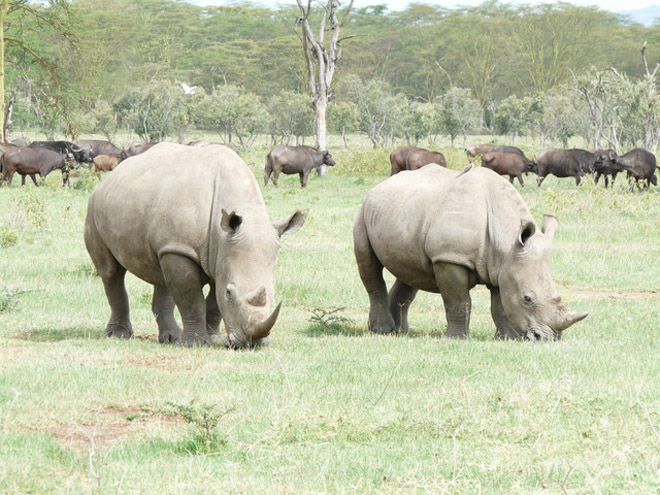

Trip to the tropics: rising water in the Rift Valley lakes

December 8, 2014
We drive out of the compound just after dawn, a convoy of four vans full of final year science students and staff. We heard lions calling beyond the fence last night, and we haven’t gone 500 meters before we see them: two males strolling off to the left. Within hours, we will have seen herds of buffalo, jackal, giraffe, vervet monkey, baboon and, most impressively, both black and white rhino, among many other birds, reptiles and mammals. The tourist in me is delighted to see so much so quickly, but there is a good reason why the animals are so close to the tracks. This is Lake Nakuru National Park in Kenya, and Lake Nakuru is rising, forcing the animals living there into a narrowing strip between the water and the boundary of the park.

The water levels in the Eastern Rift Valley lakes have a history of fluctuating wildly. From a peak in 1961, they have fallen and risen in response to drought and heavy rainfall for the last 50 odd years. Current lake levels are the highest they have been since the 60’s, but now, something very interesting is going on. Weather conditions have not changed to the degree that would predict such an extreme rise in the lake water, and people are searching for other explanations.
Some commentators believe that the changes are driven by human impacts. They claim that activities such as tree felling, house building, cultivation and increased grazing pressure have caused more water to run off the land into the rivers which feed the lakes. Because of the very seasonal rainfall, flash floods are common, and they carry large sediment loads into the lakes. This sedimentation has also been blamed for the rise of the lakes, which is a bit confusing as sedimentation was previously blamed for falling water levels. Tectonic activity has been suggested as a possible explanation: local compression of the African plate governs opening and closing of fractures through which water can seep. A change in the pattern or amount of local rock fracturing could affect water levels.

While the debate over the cause of the changes continues, there are obvious social and environmental implications. At Nakuru, the land area of the park has decreased and animals are more concentrated along the margins of the park. The problem of over grazing has intensified, animals are easier to find for tourists but also for poachers and the potential for human-wildlife conflict has increased. The lakeshore hotel at Baringo now stands under several feet of water, no longer providing jobs or bringing valuable revenue into the area from tourists. At Lake Bogoria, the lake water has become fresher as it has risen. This has inhibited the growth of the cyanobacteria upon which the lake’s iconic lesser flamingo flocks depend so flamingo numbers have fallen. But it is an ill wind that blows no-one good – rising water levels are a boon for fishermen.
Looking back over the 20th century, fluctuating water levels appear to be the norm in the Eastern Rift Valley, but they are very difficult to foresee. Knowing how frequently, how far and how fast the lakes rise and recede would be a huge benefit to local people. It is a complex problem, and one which would require a wide range of expertise and a lot of money to solve. In the meantime, the lakes are mercurial, providing and destroying land and livelihoods.
Aoife Delaney
You might also be interested in...
Van Walt Guidelines for sampling for PFAS in Groundwater
November 13, 2024We need to make clear, that at the time of writing, there are no ISO or EN standards which deal with the sampling of groundwater for PFAS.
Read MoreSpot measurement v. continuous environmental monitoring
August 25, 2023Environmental monitoring has developed considerably over the years. From the time when a consultant went out monthly or quarterly with a dip tape to monitor the groundwater level in a borehole, wind forward...
Read MoreMeasuring Nitrates (NO3, NO3-N) in the field
June 20, 2023The interest in Nitrates is nothing new. One way or another we have been measuring them for half a century.
Read MoreVan Walt Environmental Equipment
A small selection of our environmental equipment